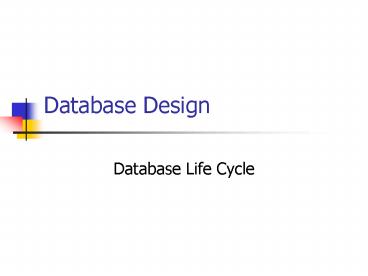Database Design - PowerPoint PPT Presentation
1 / 17
Title:
Database Design
Description:
Database Design. Database Life Cycle. Marina G. Erechtchoukova. 2. Systems Development Life Cycle ... design. DBMS software selection. Logical design. Physical ... – PowerPoint PPT presentation
Number of Views:79
Avg rating:3.0/5.0
Title: Database Design
1
Database Design
- Database Life Cycle
2
Systems Development Life Cycle
3
Database Role in Information Systems
- Major component
- Requires thorough elaboration
- Affects application structure
- Reflects information needs of functional area
- SDLC inherently links to the database lifecycle
4
Database Life Cycle (DBLC)
5
Database Initial Study
- Analyze company situation
- Operating environment
- Organizational structure
- Define problems and constraints
- Look for the source of problems
- Define objectives
- Define scope and boundaries
6
System Definition
- Describes the scope and boundaries of the
database application and major user views - User view defines what is required of a database
application from the perspective of a particular
group of users - Required data
- Required transactions
7
Database Design
- Most Critical DBLC phase
- Make sure final product meets requirements
- Focus on data requirements
- Subphases
- Conceptual design
- DBMS software selection
- Logical design
- Physical design
8
Conceptual Design
- Data modeling creates abstract data structure to
represent real-world items - High level of abstraction
- Four steps
- Requirements and data analysis
- Entity relationship modeling
- Data model verification
- Distributed database design (if distributed
database is developed)
9
DBMS Software Selection
- DBMS software selection is critical
- Advantages and disadvantages
- Factors affecting purchasing decision
- Cost
- DBMS features and tools
- Underlying model
- Portability
- DBMS hardware requirements
10
Logical Database Design
- Translate conceptual design into logical
(internal) schema - Map objects in the conceptual model to specific
DBMS constructs - Design components
- Tables
- Views
- Access authorities
- Others
11
Normalization of Logical Schema
- Business rules help to formulate functional
dependencies - Tables do not display data redundancy
- Logical schema is validated against users
transactions - Denormalization can be applied
12
Physical Database Design
- Specifications for database implementation on
secondary storage. - Expected workloads are analyzed
- Logical devices are assigned
- Adding or removing indexes
- Clustering tables
13
Design Security Measures
- System security
- Authentication
- Data security
- Access to base relations
- Access to views
14
Implementation and Loading
- Implement specifications from physical design to
create storage constructs - Create a database within the storage constructs
- Implement specifications from logical design to
build tables and other object - Populate tables with data
15
Testing and Evaluation
- Database is tested for performance, integrity,
concurrent access, and security constraints - Done in parallel with application programming
- Actions taken if tests fail
- Fine-tuning based on reference manuals
- Modification of physical design
- Modification of logical design
16
Operation, Maintenance and Evaluation
- Preventative maintenance
- Corrective maintenance
- Adaptive maintenance
- Adding new users
- Generation of database access statistics to
monitor performance - Periodic security audits based on
system-generated statistics - Periodic system usage-summaries
17
DB Design Strategy Notes
- Top-down
- Identify data sets
- Define data elements
- Bottom-up
- Identify data elements
- Group them into data sets based on business rules
- Example 3NF Synthesis

